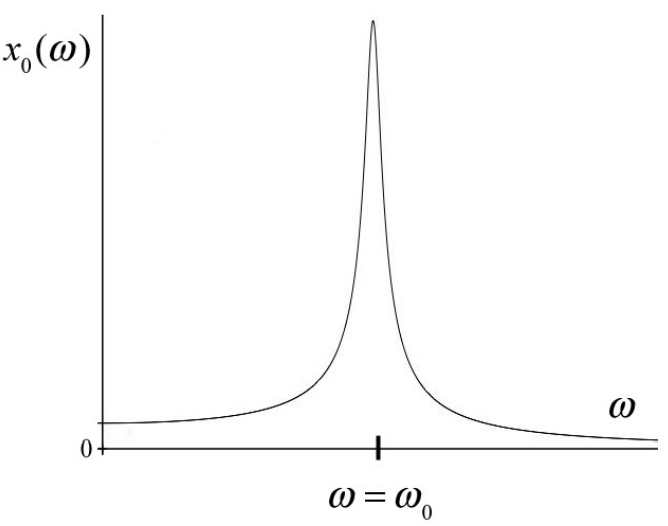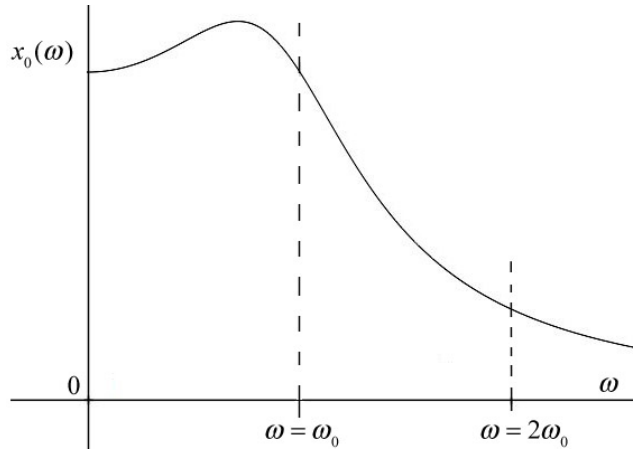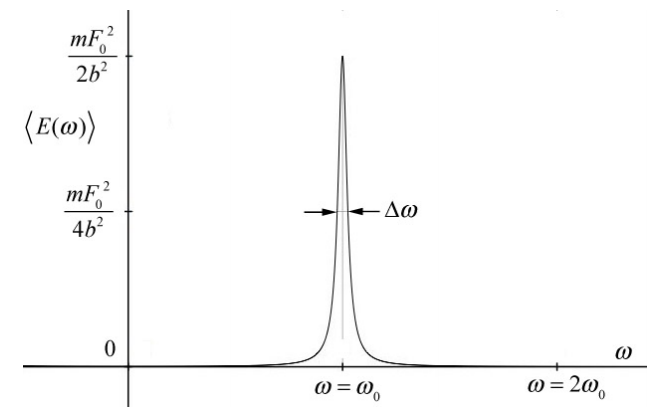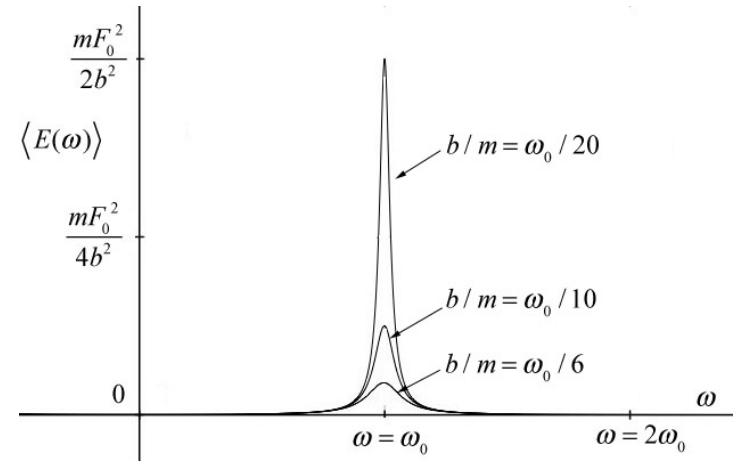23.6: Forced Damped Oscillator
( \newcommand{\kernel}{\mathrm{null}\,}\)
Let’s drive our damped spring-object system by a sinusoidal force. Suppose that the x - component of the driving force is given by
Fx(t)=F0cos(ωt)
where F0 is called the amplitude (maximum value) and ω is the driving angular frequency. The force varies between F0 and −F0 because the cosine function varies between +1 and −1. Define x(t) to be the position of the object with respect to the equilibrium position. The x -component of the force acting on the object is now the sum
Fx=F0cos(ωt)−kx−bdxdt
Newton’s Second law in the x -direction becomes
F0cos(ωt)−kx−bdxdt=md2xdt2
We can rewrite Equation (23.6.3) as
F0cos(ωt)=md2xdt2+bdxdt+kx
We derive the solution to Equation (23.6.4) in Appendix 23E: Solution to the forced Damped Oscillator Equation. The solution to is given by the function
x(t)=x0cos(ωt+ϕ)
where the amplitude x0 is a function of the driving angular frequency ω and is given by
x0(ω)=F0/m((b/m)2ω2+(ω20−ω2)2)1/2
The phase constant φ is also a function of the driving angular frequency ω and is given by
ϕ(ω)=tan−1((b/m)ωω2−ω20)
In Equations (23.6.6) and (23.6.7)
ω0=√km
is the natural angular frequency associated with the undriven undamped oscillator. The x -component of the velocity can be found by differentiating Equation (23.6.5),
vx(t)=dxdt(t)=−ωx0sin(ωt+ϕ)
where the amplitude x0(ω) is given by Equation (23.6.6) and the phase constant ϕ(ω) is given by Equation (23.6.7).
Resonance
When b/m<<2ω0 we say that the oscillator is lightly damped. For a lightly-damped driven oscillator, after a transitory period, the position of the object will oscillate with the same angular frequency as the driving force. The plot of amplitude x0(ω) vs. driving angular frequency ω for a lightly damped forced oscillator is shown in Figure 23.16. If the angular frequency is increased from zero, the amplitude of the x0(ω) will increase until it reaches a maximum when the angular frequency of the driving force is the same as the natural angular frequency, ω0 associated with the undamped oscillator. This is called resonance. When the driving angular frequency is increased above the natural angular frequency the amplitude of the position oscillations diminishes.

We can find the angular frequency such that the amplitude x0(ω) is at a maximum by setting the derivative of Equation (23.6.6) equal to zero,
0=ddtx0(ω)=−F0(2ω)2m((b/m)2−2(ω20−ω2))((b/m)2ω2+(ω20−ω2)2)3/2
This vanishes when
ω=(ω20−(b/m)2/2)1/2
For the lightly-damped oscillator, ω0>>(1/2)b/m, and so the maximum value of the amplitude occurs when
ω≃ω0=(k/m)1/2
The amplitude at resonance is then
x0(ω=ω0)=F0bω0 (lightly damped)
The plot of phase constant ϕ(ω) vs. driving angular frequency ω for a lightly damped forced oscillator is shown in Figure 23.17.

The phase constant at resonance is zero,
ϕ(ω=ω0)=0
At resonance, the x -component of the velocity is given by
vx(t)=dxdt(t)=−F0bsin(ω0t) (lightly damped)
When the oscillator is not lightly damped (b/m≃ω0), the resonance peak is shifted to the left of ω=ω0 as shown in the plot of amplitude vs. angular frequency in Figure 23.18. The corresponding plot of phase constant vs. angular frequency for the non-lightly damped oscillator is shown in Figure 23.19.


Mechanical Energy
The kinetic energy for the driven damped oscillator is given by
K(t)=12mv2(t)=12mω2x20sin2(ωt+ϕ)
The potential energy is given by
U(t)=12kx2(t)=12kx20cos2(ωt+ϕ)
The mechanical energy is then
E(t)=12mv2(t)+12kx2(t)=12mω2x20sin2(ωt+ϕ)+12kx20cos2(ωt+ϕ)
Example 23.5: Time-Averaged Mechanical Energy
The period of one cycle is given by T=2π/ω. Show that
(i) 1T∫T0sin2(ωt+ϕ)dt=12
(ii) 1T∫T0cos2(ωt+ϕ)dt=12
(iii) 1T∫T0sin(ωt)cos(ωt)dt=0
Solution: (i) We use the trigonometric identity
sin2(ωt+ϕ))=12(1−cos(2(ωt+ϕ))
to rewrite the integral in Equation (23.6.19) as
1T∫T0sin2(ωt+ϕ))dt=12T∫T0(1−cos(2(ωt+ϕ))dt
Integration yields
12T∫T0(1−cos(2(ωt+ϕ))dt=12−(sin(2(ωt+ϕ))2ω)|T=2π/ωT=0=12−(sin(4π+2ϕ)2ω−sin(2ϕ)2ω)=12
where we used the trigonometric identity that
sin(4π+2ϕ)=sin(4π)cos(2ϕ)+sin(2ϕ)cos(4π)=sin(2ϕ)
proving Equation (23.6.19).
(ii) We use a similar argument starting with the trigonometric identity that
cos2(ωt+ϕ))=12(1+cos(2(ωt+ϕ))
Then
1T∫T0cos2(ωt+ϕ))dt=12T∫T0(1+cos(2(ωt+ϕ))dt
Integration yields
12T∫T0(1+cos(2(ωt+ϕ))dt=12+(sin(2(ωt+ϕ))2ω)|T=2π/ωT=0=12+(sin(4π+2ϕ)2ω−sin(2ϕ)2ω)=12
(iii) We first use the trigonometric identity that
sin(ωt)cos(ωt)=12sin(ωt)
Then
1T∫T0sin(ωt)cos(ωt)dt=1T∫T0sin(ωt)dt=−1Tcos(ωt)2ω|T0=−12ωT(1−1)=0
The values of the integrals in Example 23.5 are called the time-averaged values. We denote the time-average value of a function f(t) over one period by
⟨f⟩≡1T∫T0f(t)dt
In particular, the time-average kinetic energy as a function of the angular frequency is given by
⟨K(ω)⟩=14mω2x20
The time-averaged potential energy as a function of the angular frequency is given by
⟨U(ω)⟩=14kx20
The time-averaged value of the mechanical energy as a function of the angular frequency is given by
⟨E(ω)⟩=14mω2x20+14kx20=14(mω2+k)x20
We now substitute Equation (23.6.6) for the amplitude into Equation (23.6.34) yielding
⟨E(ω)⟩=F204m(ω20+ω2)((b/m)2ω2+(ω20−ω2)2)
A plot of the time-averaged energy versus angular frequency for the lightly-damped case (b/m<<2ω0) is shown in Figure 23.20.

⟨E(ω)⟩=F202m(ω20)((b/m)2ω20+(ω20−ω2)2)
We can approximate the term
ω20−ω2=(ω0−ω)(ω0+ω)≃2ω0(ω0−ω)
Then Equation (23.6.36) becomes
⟨E(ω)⟩=F202m1((b/m)2+4(ω0−ω)2) (lightly damped)
The right-hand expression of Equation (23.6.38) takes on its maximum value when the denominator has its minimum value. By inspection, this occurs when ω=ω0. Alternatively, to find the maximum value, we set the derivative of Equation (23.6.35) equal to zero and solve for ω,
0=ddω⟨E(ω)⟩=ddωF202m1((b/m)2+4(ω0−ω)2)=4F20m(ω0−ω)((b/m)2+4(ω0−ω)2)2
The maximum occurs when occurs at ω=ω0 and has the value
⟨E(ω0)⟩=mF202b2( underdamped )
The Time-averaged Power
The time-averaged power delivered by the driving force is given by the expression
⟨P(ω)⟩=1T∫T0Fxvxdt=−1T∫T0F20ωcos(ωt)sin(ωt+ϕ)m((b/m)2ω2+(ω20−ω2)2)1/2dt
where we used Equation (23.6.1) for the driving force, and Equation (23.6.9) for the x -component of the velocity of the object. We use the trigonometric identity
sin(ωt+ϕ)=sin(ωt)cos(ϕ)+cos(ωt)sin(ϕ)
to rewrite the integral in Equation (23.6.41) as two integrals
⟨P(ω)⟩=−1T∫T0F20ωcos(ωt)sin(ωt)cos(ϕ)m((b/m)2ω2+(ω20−ω2)2)1/2dt−1T∫T0F20ωcos2(ωt)sin(ϕ)m((b/m)2ω2+(ω20−ω2)2)1/2dt
Using the time-averaged results from Example 23.5, we see that the first term in Equation (23.6.43) is zero and the second term becomes
⟨P(ω)⟩=F20ωsin(ϕ)2m((b/m)2ω2+(ω20−ω2)2)1/2
For the underdamped driven oscillator, we make the same approximations in Equation (23.6.44) that we made for the time-averaged energy. In the term in the numerator and the
term on the left in the denominator, we set ω=ω0, and we use Equation (23.6.37) in the term on the right in the denominator yielding
\[ \langle P(\omega)\rangle=\frac{F_{0}^{2} \sin (\phi)}{2 m\left((b / m)^{2}+2\left(\omega_{0}-\omega\right)\right)^{1 / 2}}(underdamped)\end{equation}
The time-averaged power dissipated by the resistive force is given by
⟨Pdis(ω)⟩=1T∫T0(Fx)disvxdt=−1T∫T0bv2xdt=1T∫T0F20ω2sin2(ωt+ϕ)dtm2((b/m)2ω2+(ω20−ω2)2)=F20ω2dt2m2((b/m)2ω2+(ω20−ω2)2)
where we used Equation (23.5.1) for the dissipative force, Equation (23.6.9) for the x -component of the velocity of the object, and Equation (23.6.19) for the time-averaging.
Quality Factor
The plot of the time-averaged energy vs. the driving angular frequency for the underdamped oscullator has a width, Δω (Figure 23.20). One way to characterize this width is to define Δω=ω+−ω−, where ω± are the values of the angular frequency such that time-averaged energy is equal to one half its maximum value
⟨E(ω±)⟩=12⟨E(ω0)⟩=mF204b2
The quantity Δω is called the line width at half energy maximum also known as the resonance width. We can now solve for ω± by setting
⟨E(ω±)⟩=F202m1((b/m)2+4(ω0−ω±)2)=mF204b2
yielding the condition that
(b/m)2=4(ω0−ω±)2
Taking square roots of Equation (23.6.49) yields
∓(b/2m)=ω0−ω±
Therefore
ω±=ω0±(b/2m)
The half-width is then
Δω=ω+−ω−=(ω0+(b/2m))−(ω0−(b/2m))=b/m
We define the quality Q of the resonance as the ratio of the resonant angular frequency to the line width,
Q=ω0Δω=ω0b/m

In Figure 23.21 we plot the time-averaged energy vs. angular frequency for several different values of the quality factor Q = 10, 5, and 3. Recall that this was the same result that we had for the quality of the free oscillations of the damped oscillator, Equation (23.5.16) (because we chose the factor π in Equation (23.5.16)).

